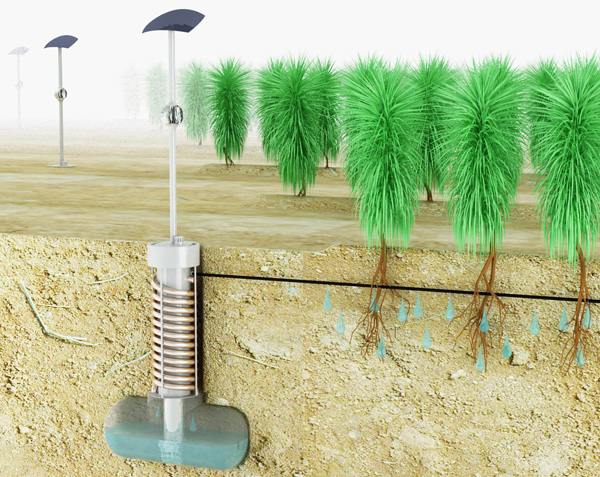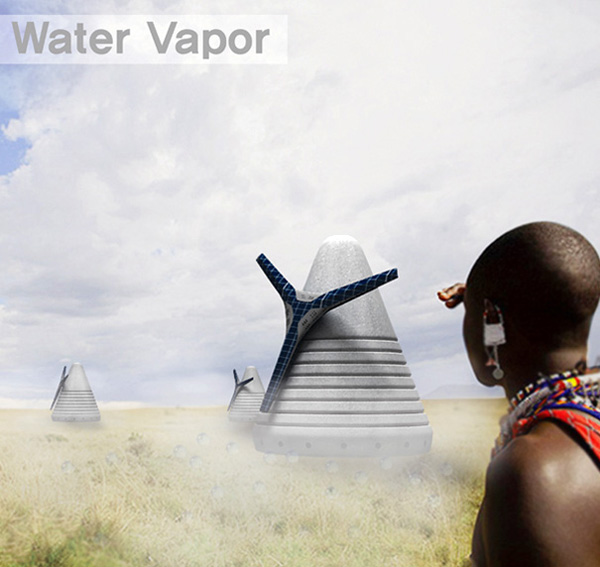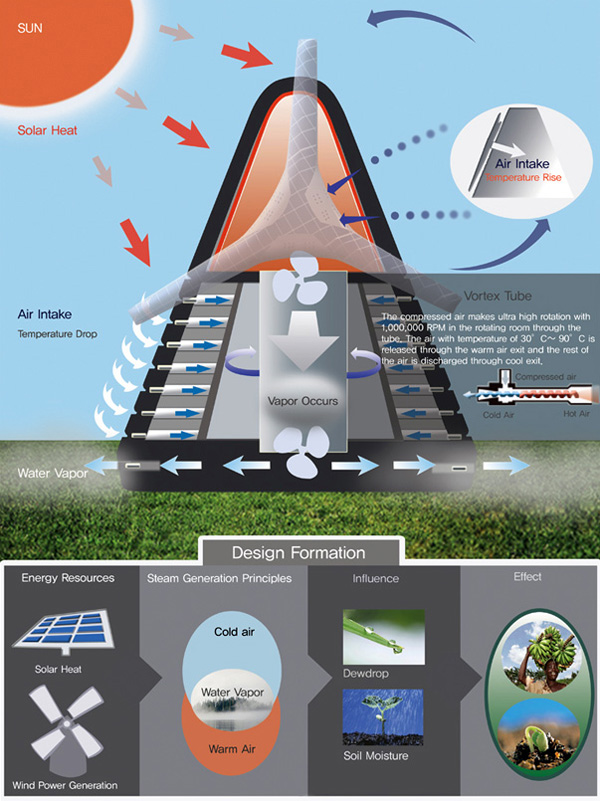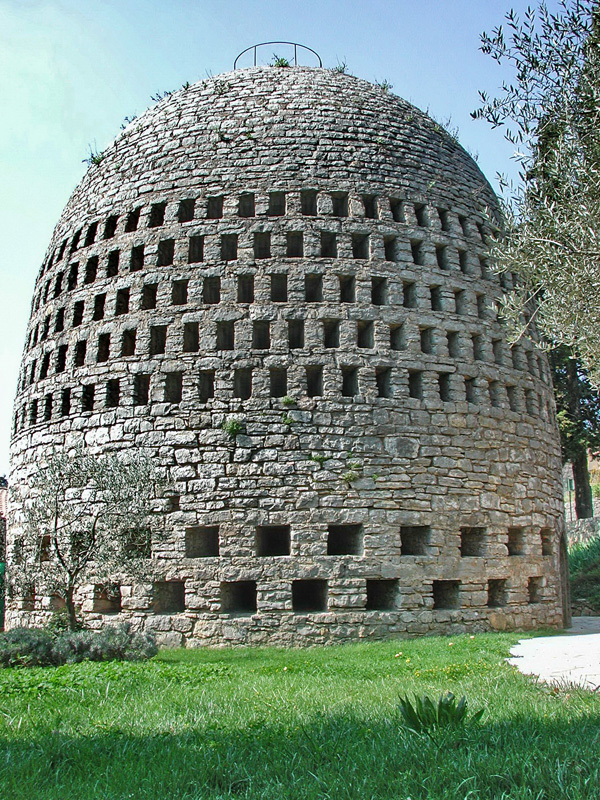
Developing efficient methods for extracting moisture from the air (condensing atmospheric humidity) has long been a goal of scientists and engineers. The AirDrop irrigation system by Edward Linnacre is one of the more recent inventions for extracting water from the surrounding air.
“The AirDrop works like a refrigerator or an air conditioner. But whereas water is just a byproduct in the other two devices, it’s the main output in this instance. An air turbine intake near the top of the device sucks air in, which is then cooled by the surrounding soil as it passes through the copper tubing to facilitate condensation. The collected water is then pumped out through a semi-permeable hose to the roots of plants. The parts that need power – the turbine and the pump – get their juice from a battery, which in turn is charged by the solar panel on top of the device.”
Source: Technabob.com


Source images 2, 3: Futuristic Design

The unique air well structure by Achille Knapen was described in Popular Mechanics Magazine, thus: “The tower… is about 45 feet tall. The walls are from 8 to 10 feet thick to prevent the heat radiation from the ground from influencing the inside temperature. It is estimated that the aerial well will yield 7,500 gallons of water per 900 square feet of condensation surface.” Note: the walls could be much thinner and thereby much less resource and labor intensive if made with earthbags, because earth doesn’t conduct heat as rapidly as stone. Add vent tubes instead of building square vents. The exterior could be plastered or covered with one layer of stone on top of rough plastered earthbags.
Source: Water – Think About it
Dew Bank
WaterCone (sadly delayed for years)
Dozens of other similar inventions for harvesting water from air are described at ResResearch.com — Airwells, Dew Ponds and Fog Fences
(seems like a comprehensive directory of information on the subject)

Hello good morning, I live on the outskirts of Lima Peru, we have done reforestation work in a community, we are reusing the water that is lost from the drainage pipes by filtering it, however the system is no longer enough to cover the more than 500 trees that we want to keep, in the area we have a temperature of 30 degrees Celsius and a humidity of 90%, please if you can send us information to implement your project here, to cover the need to keep the reforested area alive, give me your email email to send you photos of the Before and after reforestation. Thank you Juan Alarcon
The best source of information I’ve seen is at http://rexresearch.com/airwells/airwells.htm
Vivo en Venezuela y nuestra situación en cuanto al agua potable es muy mala, por lo que he investigado la humedad que tenemos es ideal para cosechar agua del aire. Me gustaria conseguir el proyecto ideal que me guíe a conseguir hacer un prototipo, soy una simple ama de casa pero con mucha inventiva. Ahora mismo cosecho el agua de la lluvia y con ello he mejorado en un 60% mi vida el problema es para los meses de verano y me vendrìa muy bien este proyecto.
Si alguien puede ayudarme, estare eternamente agradecida. Mi correo nancyperdomopalma AT gmail.com
I live in Venezuela and our situation regarding drinking water is very bad, so I have investigated the humidity we have is ideal for harvesting water from the air. I would like to get the ideal project that will guide me to make a prototype, I am a simple housewife but with a lot of inventiveness. Right now I harvest the rainwater and with it I have improved my life by 60%. The problem is for the summer months and this project would be very useful.
If anyone can help me, I will be eternally grateful. My email nancyperdomopalma AT gmail.com
researching for a water from air device using sustained energy in dessert condition for irrigation purposes
Im interested as well in these amazing technology. And I thought about installing this technology in many places other than drinking water such as: in Car (wind wiped tank and coloent tank). Also, using this technolgy in building me own water well in the middle of desert. In addition, installing one in home water tank so that I can save water bills.
For those interested in learning about the scientific and technical aspects using water-from-air systems, there is now available from amazon.com a book, “Water-from-Air Quick Guide”.
We are interested in this technology.
Regards
Farzad
Very interesting. What is the possibility of testing this inventions in other countries?
Please add me to your mailing list.
You’ll have to do deeper research for the details. This blog post just scratches the surface as far as technicalities. It’s main purpose is to draw awareness to these concepts.
Click on the Subscribe button on the right side of the page.
This is an interesting blog article…
The effectiveness of extracting water from air is quite site-specific. The dew-point temperature of the air in relation to the soil temperature would be important for the AirDrop irrigation system operation. Learn more at the following links—
Global Water-from-Air resource map: http://www.atmoswater.com/wfa-resource-map.html
Water-from-Air Resource Charts for selected locations: http://www.atmoswater.com/water-from-air-resource-charts-product-guide.html
Thanks for the advice.
And for single-family households, there’s also the Water Mill (http://inhabitat.com/the-watermill-produces-fresh-drinking-water-out-of-thin-air/).
Yes, there are lots of standard, commercially available devices, and this may be the most practical solution for most. I tend to focus on low tech and unusual DIY alternatives.